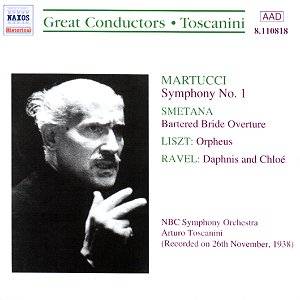
Arturo Toscanini was born in Parma, Italy, in 1867 and after studying cello,
piano and composition at the Conservatory there, he embarked on a career
as a cellist in the town. After a spell as assistant principal cellist at
La Scala (playing in the first performance of Verdi's Otello), he embarked
on a a tour of South America where he was obliged to conduct a performance
of Aida in Rio de Janiero. This he did from memory. Establishing himself
back in Italy, he became musical director of the Teatro Regio in Turin in
1895, and three years later moved on to La Scala Milan where he won an enviable
reputation for his thorough attention to every musical and dramatic detail
of operatic performance. In 1908, he was with the Metropolitan Opera in New
York returning to Italy in 1915. Five years later, he was back at La Scala
with increased powers and resources. He eventually left Europe in protest
to the encroaching tide of Fascism. In 1928, he achieved great success with
the amalgamated New York Philharmonic and New York Symphony Orchestras. Later,
in 1937, he was in charge of the orchestra specially created for him by the
National Broadcasting Company (NBC). It was with the NBC Symphony Orchestra,
that Toscanini made many of his recordings. He had such a phenomenal memory
he was able to conduct without a score. He made extreme demands on both himself
and his players and his volatile temperament frequently erupted. He is often
criticised for his rushed, insensitive performances but these live recordings
prove otherwise.
I have to admit that I was attracted to reviewing this CD because the main
work in the programme is the Martucci's Symphony No. 1. I was bowled
over by this composer's music when I first heard the ASV D'Avalos recordings
a few years ago.
Martucci (Respighi's teacher) was an Italian composer, conductor and pianist.
Martucci's virtuosity, as pianist, was admired by Liszt and Anton Rubinstein.
His role as travelling virtuoso took him all over Europe including London
and Dublin. He started conducting in 1881. His concert repertory included
many Northern European composers including Sullivan, Stanford, Parry, Mackenzie
and Cowen as well as Wagner and Brahms. He conducted the first Italian production
of Tristan and Isolde and he introduced Debussy's Prélude
à l'après midi d'un faune to Italian audiences.
Martucci's First Symphony, not surprisingly then, looks northwards over the
Alps for its inspiration. Toscanini delivers a muscular performance of the
introductory movement which is forceful and heroic, and is moulded in the
traditions of Beethoven and Schumann. Influences of Wagner and even Elgar
are evident too. Surprisingly the more sweetly romantic passages anticipate
the scores Korngold and Steiner would write for the 'women's pictures' of
the 1930s and '40s. The Andante too is a glorious sentimental wallow with
Martucci this time allowing himself typical Italian emotional excesses with
Toscanini responding with heart-on-sleeve; and it is distinguished by the
lovely cello theme which opens the movement. The Allegretto trots pleasantly
along. It is a sort of pastorale/rustic dance very reminiscent of the scherzo
of Brahms Second Symphony. The finale returns to knightly chivalry and heroic
daring-do. The listener will be struck by the similarity of many passages
to the nobilmente music of Elgar. Toscanini points up all these Pomp and
Circumstance-like flourishes and unleashes a thrilling response from the
NBC players.
Toscanini's magnificent and ultra-sensitive interpretation of Franz Lizst's
lovely symphonic poem Orpheus is captured in extraordinarily vivid
and clean sound. [It is a
Tribute to the engineering excellence of the Naxos engineers using the Cedar
process to reduce (in this work practically eliminate) clicks and crackles
and the Prism Sound SNS Noise Shaping Process.] The delicate filigree harp
figurations are wonderfully realised and Toscanini creates a rapt sensuality
full of romantic yearning as Orpheus sighs for his Eurydice. Towards the
end, following a statement of dark brooding bass figures suggesting Hades,
a powerful climax is reached as Orpheus attempts her rescue from the underworld.
Further evidence of Toscanini's attention to detail and his grasp of atmosphere
is the voluptuousness of his Daphnis and Chloé. The opening daybreak
episode is very evocative of nature in all its glory with twittering birds
and buzzing insects etc. 'Pantomime' has a heavy sweet languor and the galloping
rhythms of the 'Danse générale' thrill.
The remaining item that opens the programme is an energetic and exciting
performance of Smetana's The Bartered Bride.
A very impressive example of Toscanini's art and recommended unreservedly.
But buy the ASV recording of the Martucci Symphony to hear it in all its
glory but be careful you might get hooked!
Reviewer
Ian Lace

